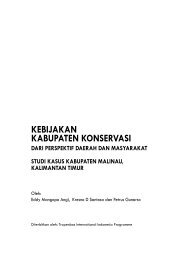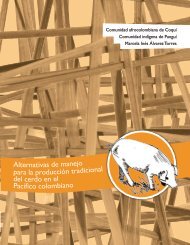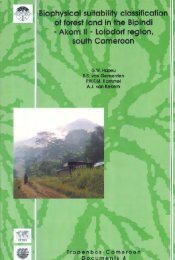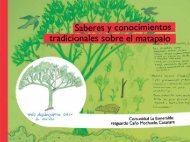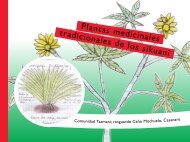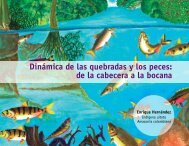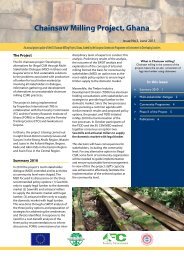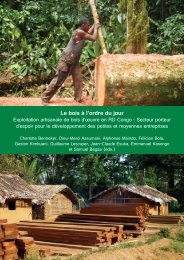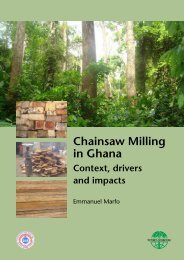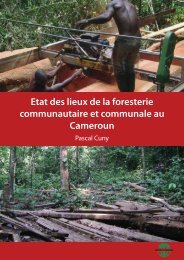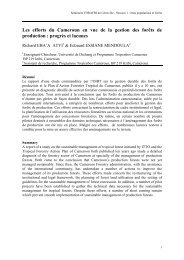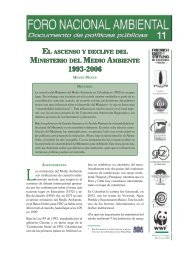Download the publication - Tropenbos International
Download the publication - Tropenbos International
Download the publication - Tropenbos International
Create successful ePaper yourself
Turn your PDF publications into a flip-book with our unique Google optimized e-Paper software.
Plant diversity in a Central African rain forest: Implications for biodiversity conservation in Cameroon<br />
forest management systems. Fur<strong>the</strong>rmore, it has been shown that mammals are<br />
primary consumers of forest fruits and seeds in tropical rain forest (Mbelli, 2002).<br />
They contribute to seed dispersal and thus to forest regeneration. It is <strong>the</strong>refore<br />
suggested that future research work be focused on plant-animal relations with<br />
emphasis on <strong>the</strong> natural regeneration of timber species and important NTFPs. This<br />
will lead to a better understanding of <strong>the</strong> dispersal, germination, growth and<br />
mortality rates of plant species as well as <strong>the</strong>ir interactions with vertebrate fruit<br />
eaters such as elephants, apes, birds, ruminants, bats and rodents.<br />
Massif des Mamelles and Mont d’Eléphant<br />
The study has also demonstrated that <strong>the</strong>re are biodiversity hotspots such as <strong>the</strong><br />
Massif des Mamelles and Mont d’Eléphant that are not located in <strong>the</strong> National Park.<br />
Unfortunately, <strong>the</strong>se areas of high conservation priority do not yet have any<br />
conservation status and are mostly found along <strong>the</strong> coast and near settlements where<br />
local human pressure is intense. As shown in Chapter 5, <strong>the</strong>re are 17 plant species<br />
strictly endemic to <strong>the</strong> Campo-Ma’an area, which are not found in <strong>the</strong> park. These<br />
endemic species are <strong>the</strong> most threatened since <strong>the</strong>ir habitats are fragmented and<br />
degraded as a result of past and present land conversion to subsistence and industrial<br />
plantations. The rate of forest degradation is likely to accelerate in <strong>the</strong> near future, if<br />
<strong>the</strong> present trends in land-use and patterns of exploitation persist. Conservation<br />
needs are exceptionally urgent in such areas since <strong>the</strong>y are of great scientific interest<br />
and under severe threat. There is an urgent need for <strong>the</strong> development of a separate<br />
management strategy in order to ensure <strong>the</strong> protection of <strong>the</strong>se biodiversity hotspots<br />
and <strong>the</strong>ir endemic species. In Cameroon forest legislation, <strong>the</strong>re are o<strong>the</strong>r forms of<br />
land-use such as community and communal forests that are compatible with <strong>the</strong><br />
conservation of biodiversity. Therefore, it is suggested that local communities be<br />
encouraged to create community forests since its management does not only focus<br />
on nature conservation but also takes into consideration <strong>the</strong>ir interests. Each<br />
community forest could have <strong>the</strong> identified biodiversity hotspot as <strong>the</strong> core<br />
conservation area, surrounded by a buffer zone in which <strong>the</strong> sustainable<br />
management of non-timber forest products and hunting are developed. In <strong>the</strong> wake<br />
of today’s forest loss, a careful sustainable land-use strategy in <strong>the</strong> buffer zones<br />
surrounding <strong>the</strong> National Park and o<strong>the</strong>r identified core biodiversity hotspots is<br />
necessary for <strong>the</strong>ir long-term survival and <strong>the</strong> protection of species of high<br />
conservation priority.<br />
Forest management units<br />
As shown in Chapter 1, logging concessions that are also called “Forestry<br />
management unit” (FMU) are <strong>the</strong> most important land-use type after <strong>the</strong> National<br />
Park. They represent about 31.4% of <strong>the</strong> Campo-Ma’an Technical Operational Unit.<br />
Some of <strong>the</strong>m (09021, 09022 and 09025, Figure 1.1 in Chapter 1) have been<br />
selectively logged at least once during <strong>the</strong> past 30 years. Although logging damages<br />
are moderate and have less effect on <strong>the</strong> forest biodiversity, fur<strong>the</strong>r logging activities<br />
should be avoided in areas that have been exploited already twice. Despite <strong>the</strong> effect<br />
of logging on <strong>the</strong>se forests, <strong>the</strong>re are still considerable patches of undisturbed forests<br />
that are characterised by a rich and diverse flora. It has become increasingly clear<br />
that National Parks cannot be protected without <strong>the</strong> establishment of a buffer zone.<br />
Therefore, FMU’s can serve as <strong>the</strong> park’s buffer zone since <strong>the</strong>y are located in its<br />
close vicinity. The management plan of <strong>the</strong> logging concessions should be<br />
120



